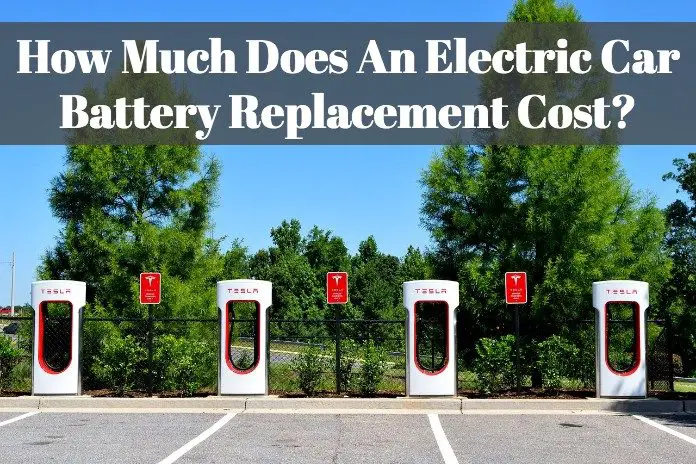
Evolution. Where would the world be without it? From using stone tools in our more primitive days to using precise medical tools that can zap cancers without cutting through the skin. In the same way, battery power has come a long way since development by Alessandro Volta.
How much would it cost you to replace an electric car battery? Well, the replacement can cost anywhere from $1,000 to $6,000. It may seem like a steep cost but there are several different factors that come into play when it comes to replacement of the battery.
For a better understanding of this, let’s take a deep dive into the world of electric vehicles.
4 Types of Electric Cars
Yes, there are types. Sort of like with fossil fuel engine cars, electric cars do come in a variety of types. With fossil fuels, you can have classification in terms of the number of cylinders, position of mounting whether front, mid-engine or rear, or even the placement of the engine to be longitudinal or transverse, among many others.
Electric cars come in four main types. These are classified according to how much they rely on electricity. These include:
1. Battery Electric Vehicles
Or as they are more commonly referred to, Electric Vehicles, or EVs. How these operate is that they rely entirely on battery charge to power the vehicle. They have no onboard fossil fuel engines to recharge the batteries and they rely solely on electricity to recharge them.
Aside from running the vehicle propulsion, the batteries also run all other electronics needed for proper functioning of the vehicle. The main selling point of EVs is that they do not emit any harmful substances into the environment.
Charging this type of electric vehicle can be done using three different standards. The first standard, known as level one, can be done when your vehicle is at home or at work. It utilizes normal voltage at home, that is 120 volts, to recharge the battery. A recharge time of eight hours will give the vehicle a range of 70 to 80 miles, depending on how much lead is in your feet.
The second standard, Level 2, uses a cable that can deliver power rated at 240 volts. This kind of power delivery requires a special charging station. You can find these at charging stations, or if your employer has provided some. For ranges of 70 to 80 miles, all you will need is four to five hours of charging time.
Level 3 chargers operate a bit differently. Instead of relying on alternating current like the two previous standards, Level 3 utilizes Direct Current. This gives it the distinct characteristic of being able to charge the batteries very quickly. Indeed, they are referred to as Fast Chargers.
DC fast charging can only be found at dedicated charging stations. If you’re looking at covering some miles and don’t have the time to charge at home, visit one of these stations. A charging time of 30 minutes can give you ranges exceeding 90 miles, subject to how hard you floor the accelerator pedal.
Vehicles in this category include the Nissan Leaf, the Chevy Bolt and the much vaunted line of Tesla vehicles.
2. Plug-in Hybrid Electric Vehicles
These are also known as Extended Range Electric Vehicles. If you’re looking to cut down your personal carbon footprint but still need to leg it across the country, this is your type of electric vehicle.
Aside from being able to recharge their batteries by plugging into charging stations, these can utilize two other methods that are onboard the vehicle to keep juice running into the battery.
The first of the two is the use of a fossil fuel engine. The power from the engine can be converted to recharge the batteries, or to power the vehicle. Some vehicles use two modes known as charge sustaining and charge depleting. For the former, the engine will charge the battery whilst driving. For the latter, the battery power will be depleted before the engine powers on to propel the vehicle and charge the battery.
The second type is known as regenerative braking. Whereas in normal braking, the energy from the momentum of the vehicle is converted into heat, sometimes sound, and therefore lost to the environment. In regenerative braking, the energy from the momentum is converted into electricity, which is then fed back into the batteries for later usage.
The most famous vehicle in this category is the Mitsubishi Outlander PHEV.
3. Hybrid Electric Vehicles
Even though electric vehicles have existed for a long time, most of us only became aware of them after the much spoken about Toyota Prius came into the limelight. These work in similar ways to the plug-in hybrid electric vehicles, the only difference being they rely on electricity generated by the regenerative braking system and the engine onboard.
These types of vehicles are praised for the great cost savings they offer drivers, with some even reporting to get mileage in the range of 48 miles per gallon of fuel. Aside from the Toyota Prius, the other famous models in this category are the Toyota Camry Hybrid and the Honda Civic Hybrid.
4. Fuel Cell Electric Vehicles
This is an alternative look at how vehicles generate and store electricity. Like Battery Electric Vehicles, these rely solely on their onboard cells to power the vehicle. These work a little bit different though. Instead of storing electricity in a battery, these store Hydrogen gas in a tank.
For electricity production, the fuel cell will then combine oxygen from the ambient air, with hydrogen from the tank to produce electricity. The electricity is then delivered straight to electric motors.
And like BEV, fuel cell vehicles do not produce any emissions. Well, not exactly true. The FCEV does produce emissions, but from your chemistry classes, you know that a combination of hydrogen and oxygen will produce water. So, no harmful emissions from this vehicle.
So, What is the Cost of Replacing Electric Car Batteries?
Electric car battery cost of replacement can vary greatly depending on a number of factors. Chief among these factors is the cost of production of these batteries. Back in the year 2010, the average cost of a battery pack was upwards of $1,000 per Kilowatt hour. That would have meant out-of-pocket costs upward of $40,000 if replacing for a 40-Kilowatt hour Nissan Leaf.
However, as manufacturing capacity grows and techniques are improving, the cost of batteries has been coming down rapidly as the years progress. With companies like Tesla and CATL building more production facilities, the cost of batteries is expected to come down to $125 by the year 2024.
Another one of the factors includes the type of electric vehicle you have. A good example to look at is the Nissan Leaf, again, which is a battery electric vehicle. At the moment, it costs $5,500 to replace its battery. However, on the other side of the spectrum things could be eye watering. In 2017, the cost of replacing the Chevy Bolt’s battery stood at a whopping $15,000.
That’s a significant drop from where it was several years ago. At the moment, standard battery costs stand at $190 per Kilowatt hour of power. Other companies like Tesla aim to produce their batteries at $125, which will make the installation of their long-range batteries cost around $10,000, and that includes labor charges.
The other significant thing to look at is, does the vehicle still have warranty coverage? Warranty could greatly impact the amount of money you will spend to replace your vehicle’s battery. It could cost you anywhere from absolutely nothing to a few thousand dollars, depending on the situation at hand.
Like with all other objects that rely on some degree of mechanics or chemistry, wear and tear is a natural phenomenon. At the moment, most EV manufacturers are offering their vehicles with an 8-year, or 100,000-mile (160,000-kilometer) warranty. Other manufacturers like Nissan are providing their vehicles with an additional 5-year or 60,000-mile coverage in the case of loss of battery capacity.
Since California adopted regulations on emissions warranty periods, manufacturers have added this coverage to vehicles that have near zero emissions. The coverage is a 10-year coverage on vehicles that rely entirely on battery power. Vehicle manufacturers have since extended this coverage to other states as well.
Conclusion
The cost of replacing an electric car battery is not a straight up figure that one can put up. It depends on a number of different factors. In some cases, batteries do not ail entirely and only a few individual cells could be malfunctioning. If you’ve got the technical nous, you could test the cells yourself and replace them for a few hundred bucks. If not, pay someone else to do it.
The good thing is with a vehicle that is still under warranty, the manufacturer will take care of replacement of the battery and you don’t have to worry about spending a lot of money. Unless the battery failed due to manufacturing defects, you can expect to get a good 10 to 15 years of life from the battery pack.





